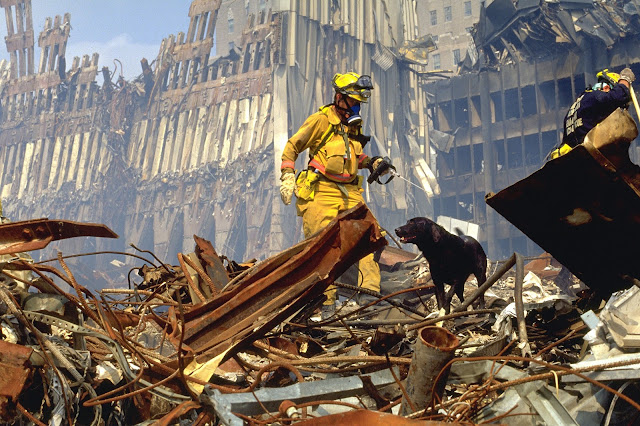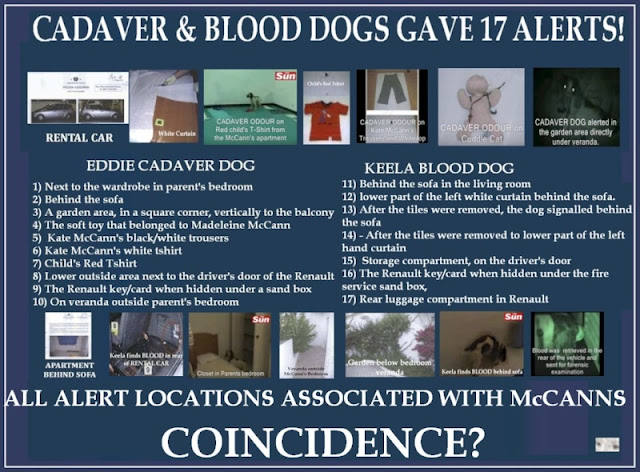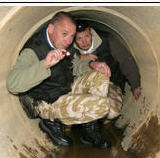Chapter 9: On the reliability of Cadaver Dogs
The Complete Mystery of Madeleine McCann™ :: Madeleine Beth McCann :: PeterMac's FREE e-book: What really happened to Madeleine McCann?
Page 1 of 1 • Share
 Chapter 9: On the reliability of Cadaver Dogs
Chapter 9: On the reliability of Cadaver Dogs
Chapter 9: On the reliability of Cadaver Dogs
On the Reliability of Cadaver dogs
Dogs trained to detect the smell of human cadaverine are now routinely used throughout the world. We examine some of the leading cases.
From the outset it is important to note that a dog cannot give “evidence“ in a criminal trial. In most jurisdictions evidence has to be subject to examination and cross examination by learned counsel, and this is clearly impossible. On many occasions the alert by the dog will result in the discovery of remains and it will be that which becomes the primary evidence. The fact that the dog indicated where to look becomes a side issue, of no particular legal importance.
Here we look at some occasions when the dog alerts, but no significant physical evidence can be found at the time. The best that can be achieved in these circumstances is that the handler of the animal gives evidence of the dog’s reactions, often with video confirmation, and can then be cross examined on his interpretation of the animal’s behaviour.
(I shall refer to the cases by the name of the deceased or missing person, rather than by the Trial reference, because of the ways in which these differ across jurisdictions)
1 The case with a legal significance may not yet have been fully appreciated, is that of Jeanette Zapata. in Dane Country, USA. In 1976 she served her husband Eugene Zapata with divorce papers. She went missing shortly afterwards. 29 years later dogs alerted in the basement of the family home, and in several other places where the family had lived over the intervening time. At trial his lawyer persuaded the judge that the dog’s finding could not be admitted, since the places in which they had alerted indicated that he had carried the body round to everywhere he had lived, and it was suggested that this was preposterous. The jury failed to reach a verdict. Before his retrial however, he confessed, and crucially confirmed that he had in fact transported the body round before disposing of it. The dogs had been absolutely accurate. No body has been found.
2 The recent case of Bianca Jones, a 2 year old girl murdered by her father D’Andre Lane in Detroit USA, with the added details of an alleged abduction, was an occasion when Mr Martin Grime, a British retired police officer, was working for the FBI. His evidence of the alerts by his dog was admitted to show that Bianca was dead whilst in the back of the car, and not taken by armed men as was being alleged. Lane was convicted, though no body has been found.
3 The trial of Adrian Prout, in 2010, for the murder of Kate Prout, his wife, in the UK, was notable again for a verdict of guilty, despite no body having been found. Dogs had indicted the presence of a body in the house, but nothing had been found. Some time after his conviction Prout confessed, and indicted the location of the body, confirming that the dogs had been absolutely accurate in their findings.
4 In the murder of Susan Pilley in Edinburgh, by her colleague David Gilroy, in 2010, the court heard that the dogs had alerted in the office basement garage and in two areas of the boot of Gilroy’s car, even though this had been cleaned recently with fluid or air freshener. The defence failed to convince the jury that the absence of physical evidence entitled his client to acquittal. He was convicted. No body has been found.
5 Cori Baker from Oklahoma was murdered by her sister’s boyfriend Marquis Bulloch, in 2007. He changed his story several times whilst being investigated, and the dogs, partly funded by the National Center for Missing and Exploited Children, were brought into search a large area after a skull had been found. They alerted in several places. No other physical evidence was discovered. He was convicted
6 The case of Guadeloupe Montano from Kane County, USA, is now complete. It is alleged that she was murdered by her husband Aurelio Montano in 1990. It may be the first time that the dog’s alerts have been used as evidence in that State. They indicate that the body lay in one position and was then moved to another. The trial took place in October 2013. No body has been found. He was convicted
7 The case of Amir Jennings, allegedly killed by her mother Zinah Jennings in 2011, involves a mother who reported her son missing. Dogs searched the house and the car, and human blood was then found. No body has been found. Zinah Jennings was convicted on a charge of unlawful conduct toward a child, and sentenced to 10 years
8 The trial of Albert Fine, the partner of Catherine Hoholski, from Lorain USA, is pending. In this case the body was found within 60 seconds of the dog being deployed, and it was then used to identify other locations relevant to the prosecution case. He faces the death penalty if convicted.
9 The alleged abduction of Isabel Mercedes Celis has been called into question by the findings of two dogs, one a cadaver dog, in the family home. The findings were said to be “significant”, the house is being treated as a crime scene and the matter is still under investigation. No body has been found.
10 The disappearance of 6 year old Etan Patz in New York 33 years ago, has already shown the almost unbelievable feats of which cadaver dogs are capable. In this case pads of absorbent material were left for a time on the concrete floor of the basement and then presented to the dogs for testing. As a result the concrete floor was then ripped up. The handler Englebert said. "We as human beings never lose our scent. If [a body] had been there for a while, that scent would still be there," she said, indicating that even if investigators do not find remains in the basement, it is possible human remains may have once been there before being moved.” The trial of Pedro Hernandez, who has admitted kidnapping and murder, is pending. No body has been found.
11 The parents of Lisa Irwin, from Kansas City, also allege that she must have been abducted in the middle of the night. The mother told Police she did not search, “because she was afraid of what she might find”. Disturbed earth was found behind the house, and the dog alerted in the parent’s bedroom. As a result a full search warrant was granted, and the police say they want to talk to the parents Jeremy Irwin and Deborah Bradley, one to one.
12 The cold case of 14 year old Melanie Melanson, from Massachusetts USA, who disappeared 20 years ago, has been given fresh impetus through the findings of a cadaver dog which alerted in an area targeted following a tip off to Police.
13 Another mother, Shakara Dickens, of Memphis USA, reported in 2010 that she had given up her daughter Lauryn Dickens for adoption, but the various stories turned out to be false. A dog identified cadaver odour in the house and in the boot of the car, and despite defence arguments, she was found guilty of Murder. No body has been found.
14 The infamous case of Caylee Anthony, whose mother Casey Anthony was accused of murdering her in Orlando USA, in 2011, was also notable in that the evidence of the cadaver dog handler was admitted, even though the body was found later at a different location. The dog alerted in the boot of the car, and it was alleged that the mother had then dumped the body. The evidence was highly detailed, with full description of the system of ‘final trained alert’ by the dog showing an exact position, distinguished from a more general interest. In the event Anthony was not found guilty of the murder, but was convicted of several lesser offences. There are moves to have the case reopened at Federal level.
15 In the UK, the case of Kirsi Gifford-Hull, in Winchester in 2005, is of interest since although the body was discovered by a man walking a dog, and the offender Mike Gifford-Hull had made a public appeal at a press conference for his wife to return, cadaver dogs had already alerted some weeks earlier in the house and in his car during the initial search for a “missing person”. After the trial he told officers that when he saw the dogs alerting in the car he had contemplated making a full admission. He was convicted. After the trial Judge Guy Boney QC ”. . .added that the police inquiry was so superior it could be matched with that of any other police force in the world.”
Many organisations exist to provide the services of cadaver dogs. Many are staffed by retired specialist Police officers. Their services are not cheap. It was widely reported, not entirely tongue in cheek, that Eddie, the cadaver dog operated by Mr Martin Grime, earned more than the Chief Constable. The Cadaver Dog Team of Global Rescue Services, and Dog Detectives operate in this sphere. Independent trainers include Search Dogs UK (www.searchdogsuk.co.uk ) All operate within the UK
Almost every state of the US has its own team operating in this way, and the FBI run training programmes specifically targeted at Cadaver and Blood detecting dogs.
The whole area of research is subject to rigourous academic study, as so much in the legal world hinges on the success or otherwise of the dogs, and the trust placed by courts on their reported findings.
Academic Papers
16 Cadaver dogs– a study on detection of contaminated carpet squares.
Abstract
Cadaver dogs are known as valuable forensic tools in crime scene investigations. Scientific research attempting to verify their value is largely lacking, specifically for scents associated with the early postmortem interval. The aim of our investigation was the comparative evaluation of the reliability, accuracy, and specificity of three cadaver dogs belonging to the Hamburg State Police in the detection of scents during the early postmortem interval.
MATERIAL AND METHODS:
Carpet squares were used as an odor transporting media after they had been contaminated with the scent of two recently deceased bodies (PMI<3h). The contamination occurred for 2 min as well as 10 min without any direct contact between the carpet and the corpse. Comparative searches by the dogs were performed over a time period of 65 days (10 min contamination) and 35 days (2 min contamination).
RESULTS:
The results of this study indicate that the well-trained cadaver dog is an outstanding tool for crime scene investigation displaying excellent sensitivity (75-100), specificity (91-100), and having a positive predictive value (90-100), negative predictive value (90-100) as well as accuracy (92-100).
17 Cadaver dog and handler team capabilities in the recovery of buried human remains in the southeastern United States.
Abstract
The detection of human remains that have been deliberately buried to escape detection is a problem for law enforcement. Sometimes the cadaver dog and handler teams are successful, while other times law enforcement and cadaver dog teams are frustrated in their search. Five field trials tested the ability of four cadaver dog and handler teams to detect buried human remains. Human and animal remains were buried in various forested areas during the summer months near Tuscaloosa, Alabama. The remains ranged in decomposition from fresh to skeletonized. Cadaver dogs detected with varying success: buried human remains at different stages of decomposition, buried human remains at different depths, and buried decomposed human and animal remains. The results from these trials showed that some cadaver dogs were able to locate skeletonized remains buried at a significant depth. Fresh and skeletonized remains were found equally by the cadaver dogs along with some caveats. Dog handlers affected the reliability of the cadaver dog results. Observations and videotape of the cadaver dogs during field trials showed that they were reliable in finding buried human remains.
18 The use of cadaver dogs in locating scattered, scavenged human remains: preliminary field test results.
Abstract
Specially trained air scent detection canines (Canis familiaris) are commonly used by law enforcement to detect narcotics, explosives or contraband, and by fire investigators to detect the presence of accelerants. Dogs are also used by police, military, and civilian groups to locate lost or missing persons, as well as victims of natural or mass disasters. A further subspecialty is "cadaver" searching, or the use of canines to locate buried or concealed human remains. Recent forensic investigations in central Alberta demonstrated that the use of cadaver dogs could be expanded to include locating partial, scattered human remains dispersed by repeated animal scavenging. Eight dog-and-handler teams participated in a two-month training program using human and animal remains in various stages of decay as scent sources. Ten blind field tests were then conducted which simulated actual search conditions. Recovery rates ranged between 57% and 100%, indicating that properly trained cadaver dogs can make significant contributions in the location and recovery of scattered human remains.
19 The suggestion that Cadaver dogs are “incredibly unreliable” is thus refuted.
References and links
1 [url=http://eddieandkeela.blogspot.com.es/2008/02/zapata-admits-killing-wife-gets-5-years.html http://www.caninesearchsolutions.org/wisconsin_v._zapata.pdf]http://eddieandkeela.blogspot.com.es/2008/02/zapata-admits-killing-wife-gets-5-years.html http://www.caninesearchsolutions.org/wisconsin_v._zapata.pdf[/url]
2 http://www.wxyz.com/dpp/news/region/detroit/jury-reaches-verdict-in-dandre-lane-murder-tria#ixzz29I3h1A3T
3 http://www.thisisgloucestershire.co.uk/Cadaver-dog-sniffed-death-Prout-home/story-11860269-detail/story.html
4 http://www.heraldscotland.com/mobile/news/home-news/david-gilroy-guilty-of-suzanne-pilley-murder.1331810187
5 http://www.tulsapeople.com/Tulsa-People/October-2010/Cold-case/index.php?cparticle=4&siarticle=3
6 http://beaconnews.suntimes.com/news/15641401-418/cadaver-dog-evidence-allowed-in-body-less-murder-case.html
http://www.charleyproject.org/cases/m/montano_maria.html
7 http://www.dailymail.co.uk/news/article-2082947/Cadaver-dogs-search-missing-toddler-police-execute-warrants-jailed-mothers-car-home.html
http://www.ibtimes.com/zinah-jennings-sentenced-10-years-disappearance-son-amir-jennings-photo-782017
8 http://www.examiner.com/article/isabel-celis-fbi-dog-alerts-missing-girls-home
9 http://childabuseconsulting.blogspot.com.es/2012/05/those-darn-cadaver-dogs.html
10 http://www.christianpost.com/news/etan-patz-case-cadaver-dogs-able-to-pick-up-scent-in-basement-73568/#vZyIRl6x8dEmovY7.99
11 http://www.dailymail.co.uk/news/article-2051903/Lisa-Irwin-missing-Cadaver-police-dog-smells-scent-dead-body-parents-bedroom.html
12 http://www.dailymail.co.uk/news/article-2181390/Breakthrough-cold-case-Cadaver-dogs-zero-place-hunt-girl-vanished-23-years-ago.html
13 http://www.commercialappeal.com/news/2012/mar/23/memphis-mother-found-guilty-presumed-dea/
14 http://www.dailymail.co.uk/news/article-2000636/Casey-Anthony-trial-continues-Cadaver-dog-handler-tells-court-overwhelmed-smell-death-trunk-Anthonys-car.html
15 http://www.standard.co.uk/news/wealthy-businessman-strangled-wife-after-she-uncovered-three-affairs-7086770.html
http://www.thisishampshire.net/news/1011044.print/
Academic links and general references
http://www.caninesearchsolutions.org/wisconsin_v._zapata.pdf
http://www.dogster.com/lifestyle/cadaver-dogs
16 "Cadaver dogs– a study on detection of contaminated carpet squares." Oesterhelweg L, Kröber S, Rottmann K, Willhöft J, Braun C, Thies N, Püschel K, Silkenath J, Gehl A.
Institute of Legal Medicine, University Medical Center Hamburg, Germany.
Forensic Sci Int. 2008 Jan 15;174(1):35-9
17 Cadaver dog and handler team capabilities in the recovery of buried human remains in the southeastern United States.
Lasseter AE, Jacobi KP, Farley R, Hensel L.
Department of Anthropology, University of Alabama, Tuscaloosa, AL 35487-0210, USA.
J Forensic Sci. 2003 May;48(3):617-21.
18 The use of cadaver dogs in locating scattered, scavenged human remains: preliminary field test results.
Komar D.
Department of Anthropology, University of Alberta, Edmonton, Canada.
J Forensic Sci. 1999 Mar;44(2):405-8.
“Incredibly Unreliable”
19.a https://www.youtube.com/watch?v=-LJo9fGXQMI
Interview with Sandra Felgueiras,
recorded 3 Nov. 2009, broadcast 5 Nov. 2009
5:39 Gerry McCann “I can tell you that we’ve also looked at evidence about cadaver dogs and they’re incredibly unreliable”.
SF “Unreliable ?"
GM: “Cadaver dogs, Yes”
19.b http://www.gerrymccannsblogs.co.uk/DAYS_851_to_1050.htm
Gerry’s blog Day 988 15/1/2010
“The use of dogs had proved to be problematic and unreliable in previous cases . . . To suggest or use the dogs’ reactions as evidence is simply wrong and abusive”
Kate McCann
19.c from “madeleine” by Kate McCann, May 2011, Bantam Press,
p. 218/9
When he arrived, Ricardo explained this ‘evidence’ a little further. His tone was sombre as he told us about the two springer spaniels that had been brought out to Portugal by the British police to assist in the search. Keela, who could alert her handler to the tiniest trace of blood, had done so in apartment 5A. Eddie, a victim-recovery or ‘cadaver’ dog, trained to detect human remains, had indicated that somebody had died there.
p.219
Did they really believe that a dog could smell the ‘odour of death’ three months later from a body that had been removed so swiftly? They were adding two and two and coming up with ten. [1]
p. 253
As we now know, the chemicals believed to create the ‘odour of death’, putrescence and cadaverine, last no longer than thirty days. There were no decaying body parts for the dog to find. It was simply wrong. [2]
p. 267
By this time Gerry was deep into his next task: researching the validity of responses produced by blood and cadaver dogs. Along the way he spoke to several experts, and in the coming weeks we would learn a lot about the subject. This is what one US lawyer had to say about the objectivity and success rate of this procedure:
The most critical question relating to the use of the dog alerts as evidence is how likely is the dog’s alert to be correct. In this regard, the only testing of these handler and dog teams recorded an abysmal performance. Here ‘the basis’ for the possible past presence of human remains is that there is a 20 or 40 per cent chance that a dog’s ‘alert’ was correct. In other words, with respect to residual odour, the dog-handler teams performed significantly worse than if the handlers had simply flipped a coin to speculate as to the presence of residual odour at each location.
State of Wisconsin v. Zapata, 2006 CF 1996 – defendant supplemental memorandum [3]
Author’s observations
1 A Cadaver dog can indeed smell the “odour of death” years, and even decades and centuries later. This statement is simply factually inaccurate, and misleading. (v.s)
2 The chemicals do last longer than thirty days. This statement is simply factually inaccurate, and misleading. (v.s.)
3 This was material submited by the defendant at First `Instance. It is not precedent, or case law. This case is notable for the change of plea before the second trial and the admission by the accused that the dog had been absolutely accurate in all its alerts, showing the various places the body had been stored over a period of three decades. ( Wisconsin v. Zapata, v.supra)
____________________
PeterMac's FREE e-book
Gonçalo Amaral: The truth of the lie
CMOMM & MMRG Blog
 MAGA
MAGA
 MBGA
MBGA
 Similar topics
Similar topics» On the reliability and admissibility of Cadaver Dogs
» Reliability of cadaver dogs - 2014 study
» Now Enough Of The Dogs....Okay. Most Cadaver Dogs Don't Lie....But His Can't Tell The Difference Between Coconut And Human Skull
» Dogs Don't Lie says Hi
» Archaeology Dogs: Cadaver Dogs on a 700 BC site
» Reliability of cadaver dogs - 2014 study
» Now Enough Of The Dogs....Okay. Most Cadaver Dogs Don't Lie....But His Can't Tell The Difference Between Coconut And Human Skull
» Dogs Don't Lie says Hi
» Archaeology Dogs: Cadaver Dogs on a 700 BC site
The Complete Mystery of Madeleine McCann™ :: Madeleine Beth McCann :: PeterMac's FREE e-book: What really happened to Madeleine McCann?
Page 1 of 1
Permissions in this forum:
You cannot reply to topics in this forum









































